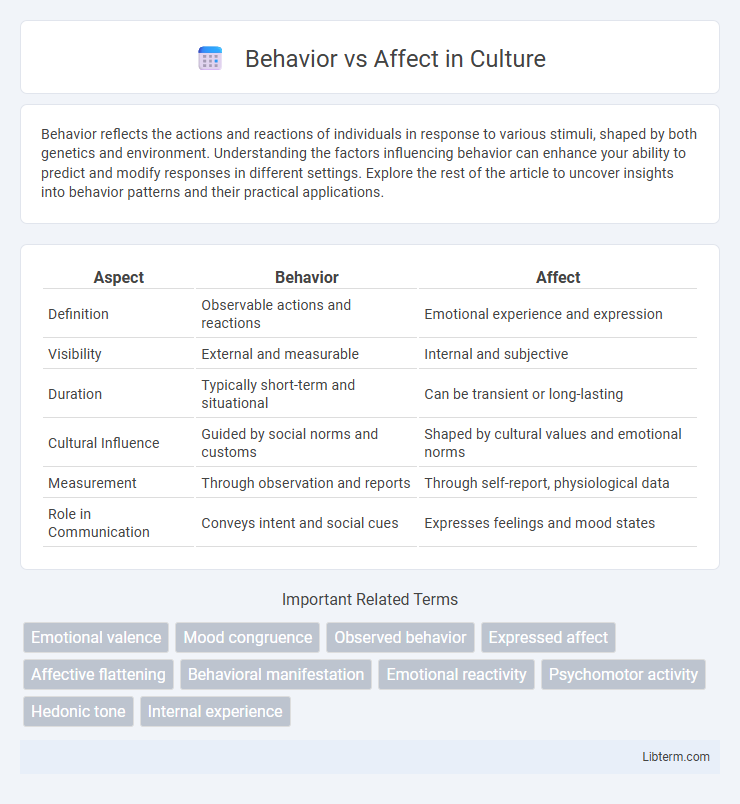Behavior reflects the actions and reactions of individuals in response to various stimuli, shaped by both genetics and environment. Understanding the factors influencing behavior can enhance your ability to predict and modify responses in different settings. Explore the rest of the article to uncover insights into behavior patterns and their practical applications.
Table of Comparison
| Aspect | Behavior | Affect |
|---|---|---|
| Definition | Observable actions and reactions | Emotional experience and expression |
| Visibility | External and measurable | Internal and subjective |
| Duration | Typically short-term and situational | Can be transient or long-lasting |
| Cultural Influence | Guided by social norms and customs | Shaped by cultural values and emotional norms |
| Measurement | Through observation and reports | Through self-report, physiological data |
| Role in Communication | Conveys intent and social cues | Expresses feelings and mood states |
Understanding Behavior and Affect: Key Differences
Behavior refers to observable actions and reactions that can be measured, while affect denotes the internal emotional experience or feelings. Understanding affect involves recognizing emotional states like happiness or anger, whereas behavior encompasses the external expression of these emotions through gestures, speech, or conduct. Differentiating behavior from affect is crucial for accurately interpreting psychological responses and tailoring effective interventions.
Defining Behavior: Actions and Observable Responses
Behavior encompasses all actions and observable responses exhibited by an individual or organism in reaction to internal or external stimuli, measurable through direct observation or recording methods. These responses can range from simple reflexes to complex interactions, serving as indicators of underlying psychological or physiological processes. Understanding behavior allows researchers and clinicians to analyze patterns and predict reactions within various environmental contexts.
What Is Affect? Exploring Emotional States
Affect refers to the underlying experience of emotion, encompassing feelings such as joy, sadness, anger, and fear that influence human behavior. It represents the immediate, subjective emotional states that shape perception and decision-making processes. Understanding affect is crucial for interpreting emotional responses, as it directly impacts motivation, mood regulation, and social interactions.
How Behavior and Affect Interact
Behavior and affect interact dynamically, as affective states often drive behavioral responses while behaviors can, in turn, influence emotional experiences. Positive affect typically encourages approach behaviors, enhancing social interactions and goal pursuit, whereas negative affect may trigger avoidance behaviors aimed at reducing discomfort. This reciprocal relationship underscores the importance of understanding how emotional states and actions co-regulate to shape overall psychological functioning.
Examples of Behavior vs. Affect in Everyday Life
Behavior in everyday life includes observable actions such as smiling when greeting someone, nodding during conversations, or helping a colleague with their workload. Affect refers to the underlying emotional experience, like feeling joy when receiving a compliment, irritation during a stressful meeting, or empathy while listening to a friend's problems. Distinguishing between behavior and affect helps in understanding how external actions connect to internal emotional states.
Measuring Behavior and Affect: Tools and Techniques
Measuring behavior involves objective tools like direct observation, behavioral coding, and sensor-based tracking to quantify actions, movements, and interactions. Affect measurement relies on techniques such as self-report questionnaires, physiological indicators (heart rate, galvanic skin response), and facial expression analysis to assess emotional states. Combining these methods ensures comprehensive data collection for understanding the interplay between observable actions and internal emotional experiences.
The Role of Culture in Shaping Behavior and Affect
Culture significantly influences both behavior and affect by shaping individuals' emotional expressions and social interactions through shared norms and values. In collectivist cultures, affect is often regulated to maintain group harmony, resulting in more restrained emotional displays, whereas individualist cultures typically encourage open emotional expression linked to personal authenticity. These cultural frameworks guide behavioral responses and affective experiences, highlighting the deep integration of cultural context in psychological processes.
Psychological Theories Explaining Behavior and Affect
Psychological theories such as the Theory of Planned Behavior emphasize the role of attitudes, subjective norms, and perceived behavioral control in predicting behavior, highlighting how cognitive processes drive actions. Affect, explained through the Affective Neuroscience framework, involves emotional responses governed by brain regions like the amygdala, influencing motivation and decision-making. The Dual-Process Model integrates these perspectives, proposing that behavior results from both automatic emotional reactions and deliberate cognitive evaluations.
Behavior and Affect in Mental Health Assessment
Behavior in mental health assessment refers to the observable actions and reactions of an individual, providing critical insights into their psychological state and functioning. Affect describes the external expression of emotions, which can be assessed through facial expressions, tone of voice, and body language to gauge mood consistency and appropriateness. Comprehensive evaluation of both behavior and affect helps clinicians identify mental health disorders, monitor symptom severity, and tailor effective treatment plans.
Practical Applications: Influencing Behavior and Affect
Behavioral interventions leverage reinforcement techniques and environmental modifications to shape actions effectively in settings such as education and organizational management. Affect regulation strategies, including cognitive reappraisal and mindfulness training, play a critical role in improving emotional well-being and decision-making processes in clinical psychology and workplace performance. Combining behavior modification with affective influence optimizes outcomes in consumer behavior, allowing marketers to tailor campaigns that drive purchasing decisions through emotional engagement and habit formation.
Behavior Infographic

 libterm.com
libterm.com